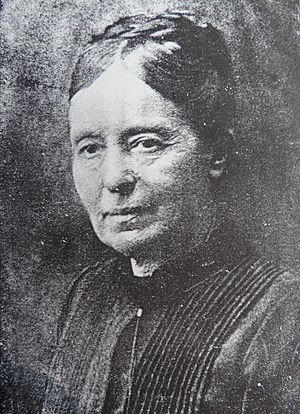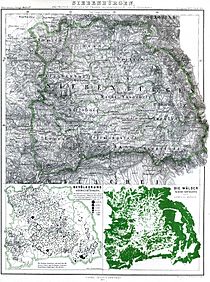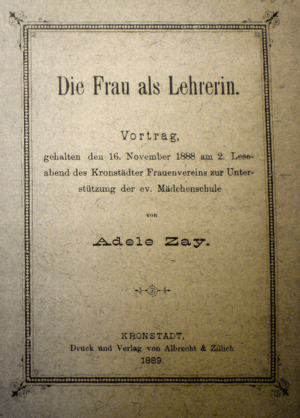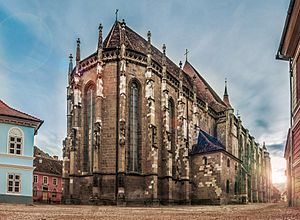Adele Zay facts for kids
Quick facts for kids
Adele Zay
|
|
|---|---|

Zay, portrait produced for the 50th anniversary of the Adele Zay School 1884–1935, Kronstadt, Romania
|
|
| Born | 29 February 1848 |
| Died | 29 December 1928 (aged 80) |
| Other names | Zay Adél |
| Occupation | teacher, pedagogue, women's rights advocate |
| Years active | 1865–1927 |
| Relatives | Gustav Adolf Zay (brother) |
Adele Zay (born February 29, 1848 – died December 29, 1928) was an important teacher and leader from Transylvania. She worked hard to improve education and fought for women's rights. Her family was part of the German-speaking community in what was then the Kingdom of Hungary.
Adele's father passed away when she was very young. This meant she sometimes had to stop her studies to teach and earn money. She used this money to continue her own education. In 1880, after studying in Vienna and Gotha, she became certified to teach in elementary schools in Germany and Hungary. The next year, she became a certified secondary school teacher. This made her the first woman in Transylvania to earn such a high level of education! From 1875 to 1884, she taught at the Institute of Irma Keméndy in Szeged.
After teaching in Szeged for almost ten years, Zay moved to Kronstadt (Brassó). She took a job at a new school that trained kindergarten teachers. Even though she was officially a teacher, Adele Zay was the main person who shaped the school. She created the entire syllabus for it. She led the school from 1884 to 1927, becoming its official director in 1922.
When she moved to Kronstadt, Zay also joined the General Women's Association. She became a key leader in fighting for women's rights. She successfully argued that kindergarten and handicraft teachers should be seen as real educators. This meant they could get pensions when they retired. She also pushed for women to be allowed to become teachers. This goal was achieved in 1901. Thanks to her efforts, a special school for women teachers opened in 1903.
Adele Zay wrote books about teaching young children. These books were used as training guides in Hungary and Germany until World War II. She also connected with other women's rights leaders from around the world. Zay strongly believed women should have the right to vote. In 1918, her work helped women gain the right to vote in church elections. In 1920, she started the Freie Sächsische Frauenbund (Free Saxon Women's League). This group helped German-speaking women in Transylvania work together for social and political rights. Transylvania had become part of the Kingdom of Romania after World War I. In the 1920s, she even became a member of parliament. She also served on the District Committee for the People's Council of Burzenland. Adele Zay stayed active in education and politics until she passed away in 1928.
Contents
Early Life and Education
Adele Zay was born on leap day in 1848. Her birthplace was Hermannstadt, in the Principality of Transylvania. This area was part of the Austrian Empire at the time. Today, it is known as Sibiu, Romania. Her parents were Rosa (née Graef) and Daniel Adolf Zay.
Adele's family were Transylvanian Saxons. This means they were part of the German-speaking, Lutheran community. These communities had been invited to settle in Transylvania by the Hungarian king starting in the 12th century. The German communities had a lot of political freedom until the late 1800s.
Adele was the fourth daughter in her family. She also had a younger brother named Gustav Adolf "Adolf". He later became a lawyer and a member of the Hungarian parliament. Adele's father was a High Court Judge. Sadly, he died shortly after her brother Adolf was born in 1850. Her mother was left with only a small pension, which wasn't enough to pay for her children's education.
Adele really wanted to become a teacher. She went to the Protestant girls' school. She also took private lessons to learn languages and natural sciences.
Adele Zay's Career
Starting as a Teacher (1865–1884)
By the time she was 17, Adele Zay had started tutoring other students. Within three years, she was teaching French and German. She taught at the Mädchenerziehungsanstalt von Philippine Barreaud (Philippine Barreaud Girls' Educational Institute) in Hermannstadt.
When that school closed in 1873, she moved to Bucharest. She taught at the Mädchenerziehungs- und Lehrerinnenbildungsanstalt Asyl Helene (Helena Asylum Girls' Educational and Teacher Training Institute). One of her older sisters also worked there as a teacher. The Helena Asylum was an orphanage started in 1862 by Elena Cuza. She was the princess of the United Principalities of Moldavia and Wallachia. Later, Queen Elisabeth of Wied supported the orphanage. Adele Zay taught German language, geography, and history classes there.
In 1875, Adele wanted to learn even more. She went to Vienna and took a special training course with Friedrich Dittes. He was a school reformer who supported the Fröbel method of teaching. She also took private lessons in Gotha with August Köhler. He also followed Fröbel's ideas and taught her about pedagogy, which is the art of teaching.
By December, Zay found a new job. She taught English, German, geography, and math at the Institute of Irma Keméndy in Szeged. While teaching, Zay continued her own studies at the Keméndy Institute's normal school. In 1880, she passed an exam to teach in German and Hungarian elementary schools. The next year, she passed another exam in Budapest. This allowed her to teach French and English. She became the first Transylvanian-Saxon teacher certified to teach at the secondary school level. She kept teaching and working as an administrator at the Keméndy Institute until 1884. At that time, the presbyterium of the Evangelical Church invited her to teach at their new school. This school was for training kindergarten teachers.
Leading the Kronstadt School (1884–1917)
After nearly ten years in Szeged, Zay accepted the job at the Kindergärtnerinnenbildungsanstalt von der Evangelischen Landeskirche-AB (KBA-AB). This was the Kindergarten Teachers Training College of the Evangelical Church. She then moved to Kronstadt (Brassó). She was hired as a classroom teacher, but from the start, Zay was the main leader of the school. She was the only woman with a higher education degree. Because of this, she was trusted to create the entire syllabus. This included classes on teaching theory, German and Hungarian languages, geography, history, and practical training.
During her studies in Germany, Zay had learned about the women's movement. So, when the General Women's Association of the Transylvanian Evangelical Church started in 1884, she joined it. She quickly became one of the main leaders fighting for women's rights. In 1888, she gave a speech called Die Frau als Lehrerin (The Woman as Teacher). In it, she argued that girls' schools run by the Church should treat women equally. She pointed out that a plan to hire women teachers had been rejected in 1887. The reason given was that the Church would have to open a special school to train them.
At the 1889 National Exhibition for Infant Education in Budapest, Zay was honored for her work. The courses she taught at her school even won the gold prize. Also that year, the KBA-AB curriculum was approved by the Hungarian government. By 1891, her work and new government rules had changed early education in Hungary.
In 1892, the school was officially recognized by the state. Two years later, Zay created a three-month course. This course trained caregivers for children in rural areas. These caregivers looked after children while their parents were busy planting and harvesting crops. The caregivers taught children their native language and customs. This helped connect rural families with the towns where the caregivers lived. Also in 1894, she successfully convinced the church leaders. She argued that kindergarten and handicraft teachers should get retirement pensions. These teachers taught practical skills and helped keep folk art alive. Before this, they were not seen as true educators.
In 1896, Zay published Theorie und Praxis der Kleinkindererziehung (Theory and Practice of Infant Education). This textbook explained how important kindergarten was for children's social growth. She taught teachers to let children learn through supervised activities and by watching others. She noted that playing together helped children develop as members of their community. This book was updated and republished in 1916 as Theorie und Praxis des Kindergartens (Theory and Practice of the Kindergarten). It was widely used in Germany to train teachers until World War II. In 1898, Zay published a second book. It was called Hilfsbüchlein zur Heranbildung von Leiterinnen von Sommerbewahranstalten (Help Booklet for the Further Education of Women Leading Summer Shelters). This book gave practical advice for teachers to organize summer activities for children. A second edition came out in 1918.
After many requests to the authorities, Zay finally succeeded in 1901. Her efforts helped open the teaching profession to women. Another big success happened in 1903. The first normal school for women in Transylvania opened in Schäßburg (Segesvár).
Zay spent her summers continuing her own education in England, France, and Germany. During these trips, she met international women's rights activists. These included Minna Cauer and Jeanette Schwerin. She began to push for changes in child labor laws. She also called for an end to hateful nationalistic talk. Most importantly, she championed equality, including the right for women to vote (women's suffrage).
Later Achievements (1918–1928)
After World War I and the Hungarian–Romanian War, Transylvania became part of the Kingdom of Romania. In 1918, women gained the right to vote in church elections. In 1920, Zay founded the Freie Sächsische Frauenbund (Free Saxon Women's League). This group aimed to bring together German-speaking women's groups. They wanted to work together for social and political changes within Romania. Through this group, she continued to push for women's education. She called for technical high school education for girls. She also introduced courses on raising children and nursery care in girls' high schools.
In 1920, Adele Zay was elected as a member of parliament. She also served on the District Committee for the People's Council of Burzenland. In 1922, she was officially named director of the KBA-AB school. She held this position until she retired in 1927. During her 43 years at the school, she helped over 830 students graduate.
In 1924, Zay made changes to the school to fit the new cultural rules set by the Romanian state. The next year, she was elected President of the Women's League. For her 80th birthday in 1928, the league organized a national fundraiser. They collected over 250,000 Romanian lei. This money was used to create the Adele Zay Foundation. Its goal was to help keep Saxon kindergartens going.
Death and Legacy
Adele Zay passed away on December 29, 1928, in Kronstadt. She had a short illness caused by a heart attack. She was the first woman to have her body displayed at the Black Church there. She was then buried in the Hermannstadt Town Cemetery, as she had wished.
Adele Zay is remembered for many important things. She helped make teaching a respected profession. She also started kindergartens in Transylvania based on Fröbel's ideas. And she worked tirelessly to empower women.
In 1929, the KBA-AB school was renamed the "Adele Zay School" in her honor. However, the Romanian government closed it in 1949. The Free Saxon Women's League, which Zay founded, was renamed the German-Saxon Federation of Women in 1930. In Drabenderhöhe, Germany, a charity organization named after her was started in 1962. This group created the Haus Siebenbürgen, Alten- und Pflegeheim (Transylvania House, Old People's Home and Treatment Center) in 1966. It cares for elderly Transylvanians. They put up a statue and a plaque honoring Zay in the entrance hall. The organization also opened a kindergarten in 1992 and another in 1995. Both are managed by the City of Wiehl.
See also
 In Spanish: Adele Zay para niños
In Spanish: Adele Zay para niños





